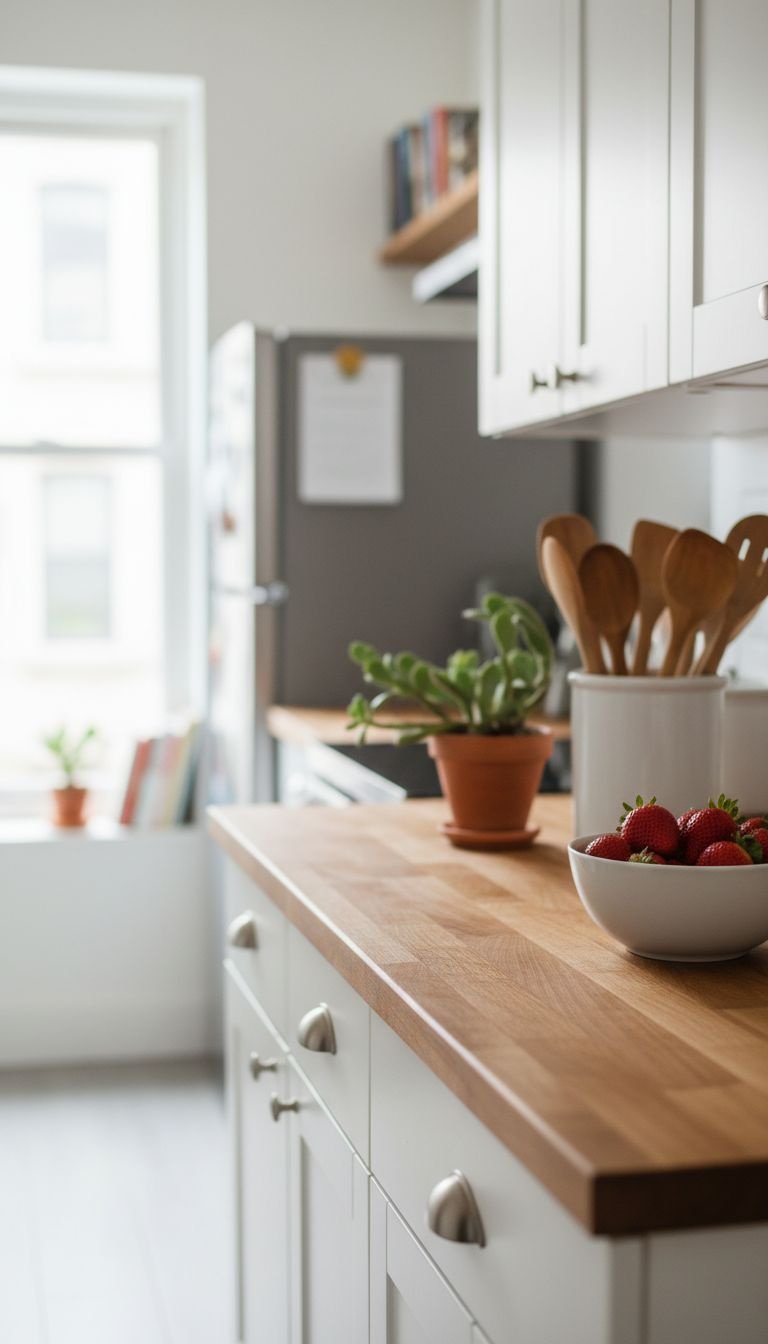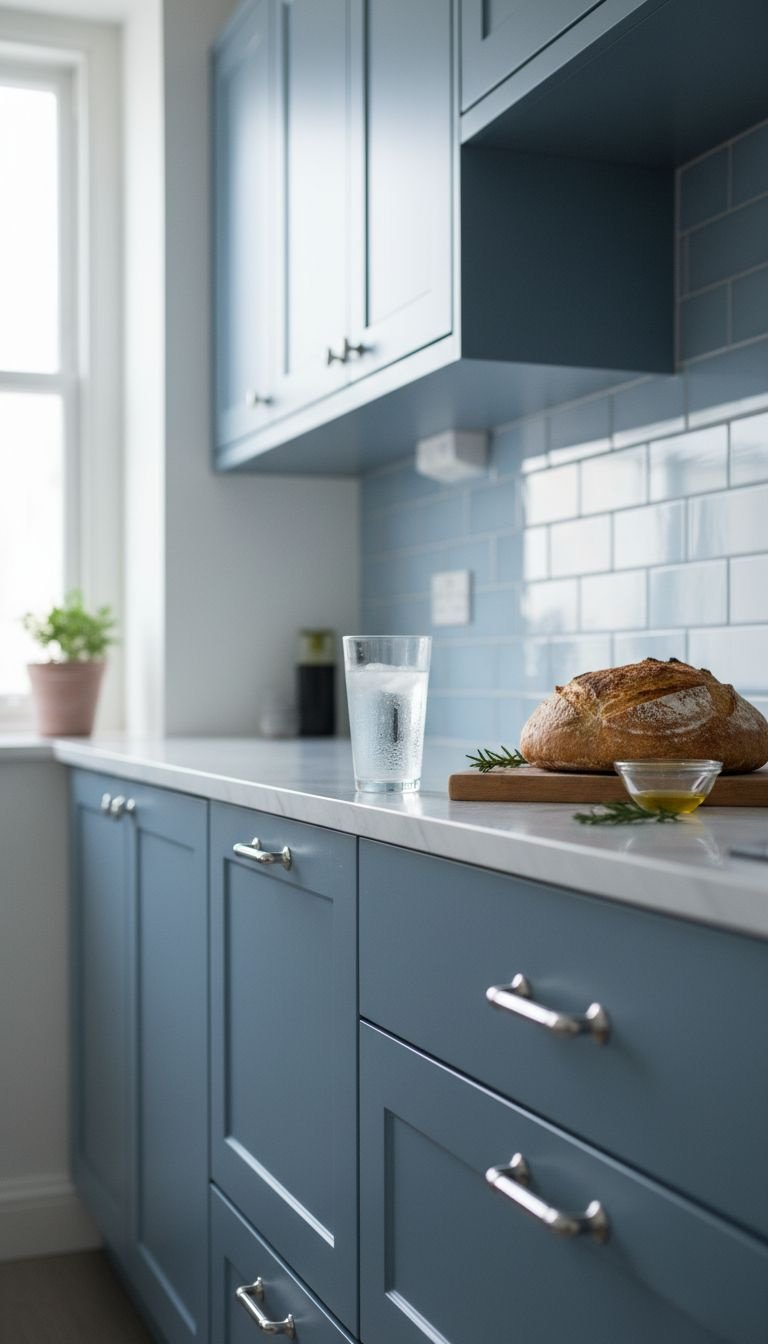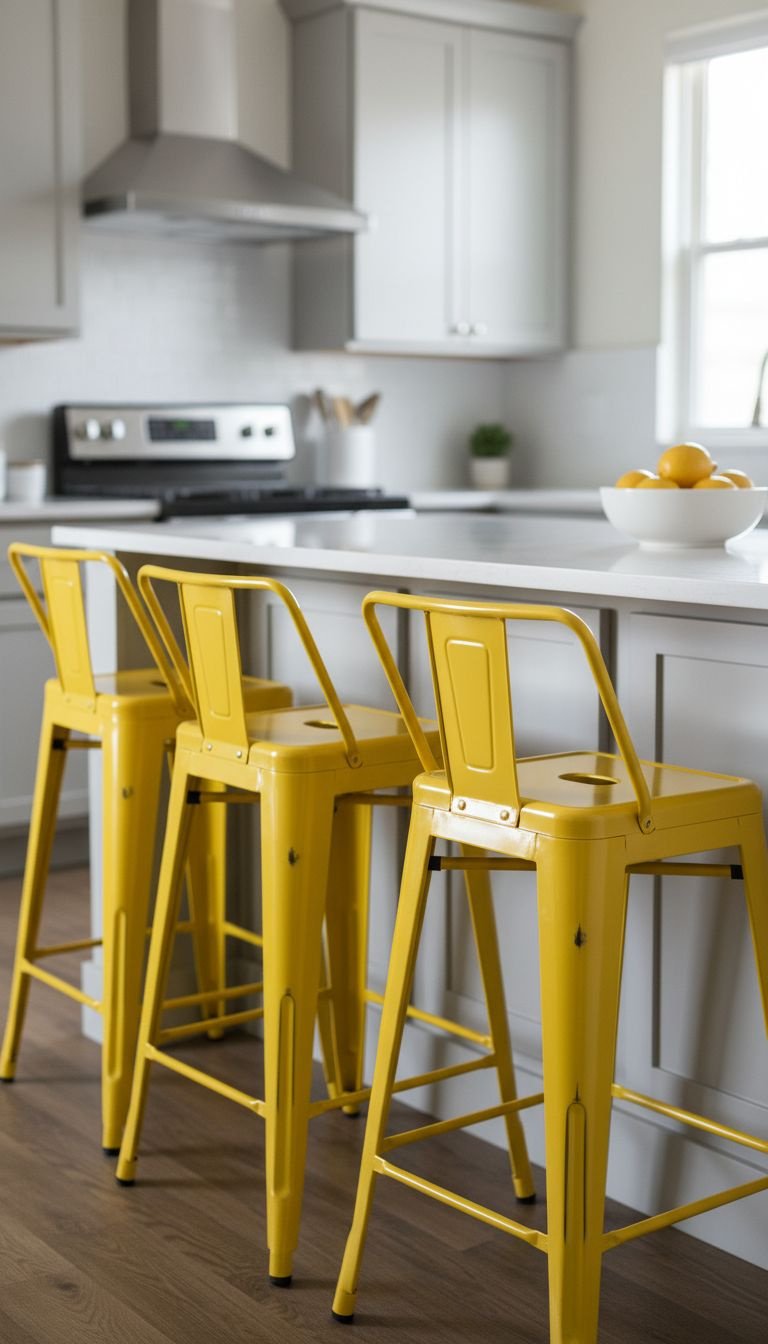As an Amazon Associate KitchenwareSets.com earns from qualifying purchases.
11 Smart Apartment Kitchen Color Ideas to Maximize Small Spaces
Struggling with a kitchen that feels small, dark, and uninspired? You’re not just imagining it; most apartment kitchens are designed for function, not feeling good. This can leave you feeling stuck with a boring, builder-grade box you can’t change.
The best apartment kitchen color schemes use light, reflective colors to create an illusion of space and brightness. This guide will show you 11 designer-approved ideas, from simple paint tricks to clever, rental-friendly hacks, to help you create a kitchen you’ll actually love spending time in.
Is Your Apartment Kitchen Feeling Cramped and Drab?
If you’re staring at a tiny, poorly-lit kitchen with generic white or beige cabinets, you understand the frustration. It’s a common story for renters and small-space dwellers. The challenges are real: limited square footage, a lack of natural light, and the biggest hurdle of all—landlord restrictions that make permanent changes impossible. You’re left feeling like you’re stuck with a boring white kitchen that has zero personality.
But what if that bland box is actually a blank canvas? The solution isn’t about wishing for more space; it’s about using color strategically to maximize the space you have. The best colors for an apartment kitchen maximize light and create an illusion of space. High Light Reflectance Value (LRV) colors like off-white, soft gray, and pale blue are excellent for walls, while clever two-tone cabinet schemes can make ceilings feel higher. This guide is packed with 11 smart, actionable design solutions that work with these constraints, not against them.
11 Smart Apartment Kitchen Color Ideas to Maximize Your Small Space
Forget thinking of color as just paint on a wall. Each of the following 11 ideas is a strategic solution designed to solve a specific small-kitchen problem—from making the ceiling feel taller to adding a huge splash of personality without touching a paintbrush. We’ll cover designer-approved principles for both renters and owners, focusing on clever updates for cabinets, walls, and backsplashes that blend timeless style with modern function. Get ready to transform your kitchen from cramped to charming.
1. The High-Reflectance White & Warm Wood Combo

Pin this timeless look for a brighter kitchen!
This classic combination is a go-to for designers for a reason. Pure white cabinets with a satin or semi-gloss finish have a high LRV, bouncing light around to make even the smallest, darkest kitchen feel bright and open. Pairing them with the natural texture of a wood countertop or butcher block prevents the space from feeling sterile and adds essential warmth and character.
Key Elements for this Look:
- Cabinet Paint: A pure white paint with a satin or semi-gloss finish to maximize light reflection (High LRV).
- Countertops: Natural butcher block or high-quality wood-effect laminate for warmth.
- Backsplash: Simple white ceramic subway tile with a light gray grout.
- Hardware: Matte black or brushed gold knobs and pulls for a touch of modern contrast.
- Decor: Small green plants (like succulents or herbs) and woven textures (like a jute runner).
How to Get the Look:
- Prep & Paint: If painting, thoroughly clean, sand, and prime cabinets. Apply 2-3 coats of high-reflectance white cabinet paint.
- Add Warmth: Install a butcher block countertop or use a high-quality, removable wood-look contact paper on existing counters for a rental-friendly version.
- Install Backsplash: Apply classic white subway tiles. For renters, use peel-and-stick subway tile for an identical look without permanence.
- Update Hardware: Swap out old knobs and pulls for your new matte black or gold hardware.
- Accessorize: Bring in natural elements like a small herb garden on the windowsill to complete the look.
Pro-Tip: Choose a white paint with a very slight warm undertone to prevent the kitchen from feeling cold or clinical, especially in rooms with cool-toned LED lighting.
2. The Two-Tone Ceiling Lift Trick

Save this idea to make your kitchen feel taller!
This is a classic designer technique to add sophisticated color while making a room feel taller. By painting the lower cabinets a darker, grounding color (like navy blue or charcoal gray) and the upper cabinets a crisp white that blends into the walls and ceiling, you draw the eye upward. This blurs the line where the kitchen ends and the ceiling begins, creating a powerful illusion of height.
Key Elements for this Look:
- Lower Cabinet Paint: A deep, saturated color like navy blue, forest green, or charcoal gray in a satin finish.
- Upper Cabinet & Wall Paint: A crisp, clean white that matches the ceiling color to blur the line and create height.
- Countertops: A light-colored countertop, such as white quartz, marble-effect laminate, or light butcher block.
- Hardware: Polished brass or nickel pulls to bridge the light and dark colors.
How to Get the Look:
- Establish the Line: Use painter’s tape to create a perfectly level line where the upper and lower cabinets meet.
- Paint Uppers: Paint the upper cabinets and the walls above them the same shade of bright white. Carry this color onto the ceiling.
- Paint Lowers: Paint the lower cabinets your chosen dark, grounding color.
- Connect with Hardware: Install the same hardware on both upper and lower cabinets to create a cohesive, unified look.
Pro-Tip: This technique works best in kitchens with at least 8-foot ceilings. For lower ceilings, keep the dark color’s saturation a bit lower to avoid feeling too heavy.
3. The Calming & Sophisticated Sage Green

Pin this calming color for a peaceful kitchen vibe.
One of the top kitchen color trends in 2025, sage green is the perfect choice for creating a space that feels both modern and serene. This earthy, muted green has gray undertones that give it a sophisticated, calming quality. It acts as a “new neutral,” adding personality and color without being overwhelming, and it connects the kitchen to the natural world.
Key Elements for this Look:
- Cabinet Paint: A muted, mid-tone sage or olive green with gray undertones, preferably in a matte or eggshell finish.
- Wall Color: A soft, warm white or a very light beige to keep the space bright.
- Accents: Natural wood elements, like a cutting board, utensil holder, or floating shelves.
- Hardware: Brushed brass or matte black for a modern touch.
How to Get the Look:
- Choose Your Green: Select a sage green paint sample and test it in your kitchen’s light. Greens can change dramatically depending on warm or cool lighting.
- Paint Cabinets: Apply your chosen green paint to all cabinets for a cohesive look.
- Balance with Neutrals: Paint walls a warm white to balance the green and prevent the room from feeling dark.
- Incorporate Wood: Add at least one or two wood elements to enhance the natural, earthy feel. Open shelving is a great way to do this.
Lesson Learned: Sage green pairs beautifully with the stainless steel of most apartment appliances, making it an easy color to integrate without everything needing to match perfectly.
4. The High-Impact Peel-and-Stick Backsplash

Save this genius rental-friendly hack!
For renters, the backsplash is often the most frustratingly dated part of the kitchen. A peel-and-stick tile backsplash is the ultimate high-impact, low-commitment solution. Modern versions are incredibly realistic, heat and moisture-resistant, and can be installed in an afternoon. This allows you to introduce a bold pop of color or a sophisticated pattern to your kitchen in a completely temporary way.
Materials Needed:
- Peel-and-Stick Tiles: High-quality, heat and moisture-resistant vinyl tiles in a color or pattern you love.
- Cleaning Solution: A degreasing cleaner to prep the existing wall or tile.
- Measuring Tape & Level: To ensure straight lines.
- Utility Knife or Scissors: For cutting tiles to fit around outlets and corners.
- Smoothing Tool: A small plastic squeegee or credit card to press out air bubbles.
Step-by-Step Directions:
- Clean the Surface: Thoroughly clean your existing backsplash or wall with a degreaser and let it dry completely. A clean surface is critical for adhesion.
- Measure and Plan: Measure the area and plan your starting point, usually in the center, working your way out. Use a level to draw a guideline.
- Peel and Stick: Peel the backing off your first tile, align it with your guideline, and press firmly onto the wall.
- Overlap and Repeat: Most peel-and-stick tiles have a small overlap area. Align the next tile, overlapping as directed, and continue until the area is covered.
- Cut to Fit: Use a utility knife to carefully cut tiles to fit around outlets and at the end of rows.
Pro-Tip: Order about 10% more tile than you calculate for your square footage. This will cover any cutting mistakes or misaligned pieces without having to re-order.
5. The Warm & Inviting Greige Foundation

Pin this sophisticated neutral for a timeless look.
If you’re looking for a timeless neutral that’s more interesting than white but not as cool as gray, greige is the answer. This perfect blend of gray and beige creates a warm, sophisticated, and inviting foundation for your kitchen. It’s incredibly versatile, pairing equally well with modern matte black hardware for a high-contrast look or with warm brass for a softer feel.
Key Elements for this Look:
- Cabinet Paint: A high-quality greige paint. Look for one with warm, beige undertones.
- Hardware: Matte black handles and knobs for a bold, graphic contrast.
- Wall Color: A creamy, warm off-white. Avoid stark, cool whites.
- Accents: Layer in textures like linen dish towels, ceramic pottery, and warm wood cutting boards.
How to Get the Look:
- Find Your Greige: Test several greige samples. Some lean more gray, others more beige. Pick the one that best complements your countertops and flooring.
- Create Contrast: Paint the cabinets your chosen greige and install matte black hardware for a strong visual anchor.
- Layer Warmth: Use a warm off-white on the walls and add warm-toned light bulbs (2700K-3000K) to enhance the cozy feeling.
- Accessorize with Texture: The key to a beautiful neutral room is texture. Add wood, linen, and ceramic pieces to create visual interest.
Pro-Tip: Greige is a “chameleon color” that changes in the light. It’s extra important to paint a large sample board and move it around your kitchen for 48 hours before committing.
6. The Bold, Removable Accent Wall

A perfect rental solution! Pin this for a pop of personality.
Want to add a major dose of personality to a bland kitchen? A bold accent wall using removable peel-and-stick wallpaper is a game-changer for renters. It’s a completely reversible way to bring in pattern and vibrant color. Choose a small, contained wall—like the one behind your breakfast nook or a blank wall perfect for open shelving—to create a powerful focal point without overwhelming the space.
Materials Needed:
- Removable Wallpaper: Choose a high-quality peel-and-stick wallpaper in a pattern you love.
- Floating Shelves: Simple, minimalist shelves, either white or a light wood tone.
- Application Kit: A squeegee, craft knife, and measuring tape are essential.
- Wall Cleaner: To prep the surface for best adhesion.
Step-by-Step Directions:
- Choose Your Wall: Select a small, contained wall for the most impact, like the wall behind a small breakfast nook or an empty wall where you can add shelves.
- Prep the Wall: Clean the wall thoroughly and let it dry. A smooth, clean surface is key.
- Apply the Wallpaper: Following the manufacturer’s instructions, apply the peel-and-stick wallpaper, starting from the top and smoothing down to remove air bubbles. Overlap seams slightly.
- Install Shelves: Once the wallpaper is up, install your floating shelves directly over it. Use appropriate wall anchors for stability.
- Style Simply: Style the shelves with neutral items (white dishes, clear glasses) to let the wallpaper be the star.
Lesson Learned: Don’t have a spare wall? You can apply removable wallpaper to the back of a glass-front cabinet or even the side of your refrigerator for a smaller, but still impactful, color pop.
7. The Monochromatic Cool Blue Scheme

Pin this chic and calming monochromatic look.
Using a monochromatic color scheme—different tints and shades of a single color—is a sophisticated way to create a bold yet harmonious look. A dusty, mid-toned blue on the cabinets paired with a slightly lighter blue on the walls creates a calm, cohesive, and high-end feel. The key is to introduce a neutral break, like a white marble countertop, to keep the color from feeling overwhelming.
Key Elements for this Look:
- Paint Color Strip: The easiest way to plan is to pick one paint color strip and use 2-3 shades from it.
- Dominant Color: Use the mid-tone shade for the largest surface area, usually the cabinets.
- Lighter Shade: Use a lighter tint of the same color for the walls.
- Darker Shade: Use a darker shade for an accent, like a kitchen island base or a statement piece of decor.
- Neutral Break: Incorporate a neutral like white or light gray for countertops and ceilings to prevent the color from being overwhelming.
How to Get the Look:
- Select Your Hue: Choose your core color (e.g., a dusty blue, a soft green, a warm gray).
- Assign Tones: Apply the mid-tone to cabinets.
- Go Lighter: Paint the walls in the lightest shade from your chosen color family. This will keep the room feeling open.
- Add Depth: If you have an island or a small accent area, use the darkest shade there. If not, use it in textiles like a floor mat.
- Break it Up: Ensure your countertops and ceiling are a crisp neutral to provide visual relief.
Pro-Tip: Texture is key in a monochromatic room. Mix finishes—like satin cabinets, matte walls, and a glossy backsplash tile—all in the same color family to create interest.
8. The Sophisticated High-Contrast Black and White

Pin this classic, high-impact combination!
Nothing says timeless elegance quite like a black and white color scheme. To make this high-contrast look work in a small apartment kitchen, the key is balance. Ground the space with dramatic matte black on the lower cabinets only, then keep everything above—walls, backsplash, and any upper shelving—a crisp, bright white. This adds drama and sophistication without making the room feel heavy or dark.
Key Elements for this Look:
- Black Paint: A true matte black for lower cabinets or an island to ground the space.
- White Surfaces: Crisp white for walls, upper cabinets (if any), and backsplash. White subway tile with black grout is a classic choice.
- Warm Accents: Wood and metallic accents (like brass or chrome) are essential to keep the look from feeling too stark.
- Lighting: Good lighting is crucial. Ensure you have bright overhead and under-cabinet lighting.
How to Get the Look:
- Ground with Black: Paint only the lower cabinets black. This adds drama without making the room feel dark.
- Brighten with White: Keep all other walls and surfaces a clean, bright white.
- Add Texture: A textured white backsplash, like beveled subway tile, adds interest.
- Introduce Warmth: This is the most important step. Add a wood butcher block, a vintage runner with warm tones, or brass hardware to soften the look.
Lesson Learned: If painting cabinets black is too much commitment, start by painting an interior door black or using black accents like bar stools, light fixtures, and picture frames.
9. The Cheerful Pop of Unexpected Yellow

Save this happy idea for an instant mood boost!
If your kitchen is a sea of neutral white, gray, or beige, the fastest way to inject energy and personality is with a single, bold pop of an unexpected color. Sunny yellow is a fantastic choice because it’s cheerful, energetic, and creates an instant focal point. This isn’t about painting walls; it’s about a strategic, budget-friendly accent.
Supplies Needed:
- The Neutral Base: This idea works best in a kitchen that is already mostly white, gray, or black.
- Your Yellow “Thing”: Choose one or two items to be your color focus. Great options include:
- Bar stools
- A small kitchen appliance (like a stand mixer or toaster)
- A roman shade for the window
- A vibrant piece of art
- A colorful runner rug
- Spray Paint (Optional): A can of high-quality yellow spray paint can transform old bar stools or picture frames.
Quick Steps:
- Choose Your Player: Decide on the one main element that will carry the accent color. Bar stools or a window treatment often have the most impact.
- Introduce the Color: Either purchase the item in a bold yellow or DIY it with spray paint.
- Echo Subtly: Add one or two very small echoes of the color elsewhere, like a bowl of lemons on the counter or a yellow-striped dish towel. Don’t overdo it.
- Keep Everything Else Calm: Let the yellow accent be the star by keeping the rest of the decor simple and neutral.
Pro-Tip: The key to using a bold accent color like yellow is restraint. One or two statement pieces are chic; ten yellow things can feel overwhelming.
10. The Budget-Friendly Cabinet Refresh with Contact Paper

Can you believe this isn’t paint? Pin this amazing rental hack!
If you’re dreaming of new cabinets but your lease (or budget) says no, removable contact paper is your secret weapon. This isn’t the flimsy liner from your grandma’s pantry; modern, high-quality vinyl contact paper can give flat-front cabinets a smooth, durable, and colorful new finish. It’s a meticulous DIY project, but the result is a dramatic transformation that can be peeled off when you move.
Materials Needed:
- Removable Contact Paper: Choose a high-quality, thick vinyl contact paper in your desired color and finish (matte is often most forgiving).
- Screwdriver: To remove cabinet doors and hardware.
- Degreasing Cleaner: For prepping the cabinet surfaces.
- Application Kit: A smoothing tool, measuring tape, and a sharp craft knife.
- Hair Dryer: Helps to stretch the vinyl around corners.
Step-by-Step Directions:
- Remove and Clean: Unscrew a cabinet door and its hardware. Thoroughly clean the door front and edges with a degreaser and let it dry. This trick works best on flat-front, non-porous cabinets.
- Measure and Cut: Lay the door on your contact paper and cut a piece that is several inches larger than the door on all sides.
- Apply Slowly: Peel back a small section of the backing and apply the contact paper to one edge of the door. Use the smoothing tool to slowly press the vinyl down, working your way across the door to eliminate air bubbles.
- Wrap the Edges: Use a hair dryer on a low setting to gently warm the vinyl as you wrap it around the edges of the door for a seamless look.
- Trim and Reassemble: Use the craft knife to trim the excess vinyl from the back and cut out the holes for the hardware. Reattach the hardware and hang the door.
Pro-Tip: Start with a small, inconspicuous drawer front or door to practice your technique before tackling the more visible cabinets.
11. The “No-Paint-Needed” Colorful Decor Strategy

Pin this if you can’t paint! Color without commitment.
If painting or applying vinyl feels like too much, you can still create a dramatic color story using only decor and textiles. This is the ultimate non-damaging, budget-friendly approach. The secret is to start with an “anchor” piece, like a patterned runner rug, and use it to define your color palette. Then, layer in functional items in those same colors.
What You Need (Your Color “Kit”):
- A Runner Rug: This is the anchor. Choose a runner with a pattern and a clear color palette (e.g., navy, coral, and cream).
- Dish Towels & Oven Mitts: Find a set that pulls one of the main colors from your rug.
- Countertop Decor: Canisters, a utensil crock, or a fruit bowl in your chosen accent color.
- A Small Appliance: A toaster, kettle, or coffee maker can be a fantastic color statement.
- Artwork: A small, framed print that incorporates your color palette.
- Magnetic Spice Rack (Optional): Attach to the side of your fridge and fill with colorful spices.
How to Do It (The Layering Method):
- Start with the Floor: Lay down your runner rug. This establishes the entire color palette for the space.
- Add Functional Color: Drape the coordinating dish towels over the oven or sink handle. Place the colorful utensil crock by the stove.
- Create a “Moment”: Group your colorful canisters or small appliance in a corner to create a deliberate, styled vignette.
- Look Up: Hang your piece of art on any available wall space or simply lean it against the backsplash.
- Edit and Refine: Step back. If it feels too busy, remove one item. The goal is a cohesive, not chaotic, look.
Pro-Tip: Choose just one or two main colors from your runner rug to repeat in your accessories. Trying to match every color will make the space feel cluttered.
Key Takeaways: Your Quick Guide to a Better Apartment Kitchen
- Maximize Light: Use light colors (whites, light grays) with a satin or semi-gloss finish to reflect as much light as possible.
- Create Illusions: Employ tricks like two-tone cabinets (dark bottom, light top) or vertical patterns to make the space feel taller.
- Focus on Reversible Changes: If you’re a renter, prioritize high-impact, non-permanent updates like peel-and-stick backsplashes, removable wallpaper, and colorful decor.
- Add Warmth to Neutrals: Balance whites, grays, and blacks with natural textures like wood and woven materials to keep the space from feeling cold.
- Use Color Strategically: A small amount of a bold, saturated color on an accent piece or through decor can have more impact than painting everything.
People Also Ask About Apartment Kitchen Color Schemes
What are the best colors for a small apartment kitchen?
Light, neutral colors are the safest and most effective choice for making a small apartment kitchen feel larger. Colors like off-white, light gray, soft beige, and pale pastels (like mint green or sky blue) have a high Light Reflectance Value (LRV), meaning they bounce light around the room, creating a bright and airy feel.
How can I add color to my rental kitchen without painting?
Focus on textiles and accessories. You can add significant color by using a vibrant runner rug, colorful dish towels, and a window treatment. Other great options include purchasing small appliances in a fun color, using peel-and-stick tiles for a temporary backsplash, or hanging a large piece of art.
Are white kitchens going out of style in 2025?
No, white kitchens are a timeless classic that will likely never go completely out of style. However, the trend in 2025 is to warm up all-white kitchens with natural wood accents, textured backsplashes, colorful hardware like brushed brass, and by layering in warm neutral tones like beige and cream.
What is the 60-30-10 rule for a kitchen?
The 60-30-10 rule is a simple guideline for creating a balanced color palette. 60% of your room should be a dominant color (typically the walls). 30% should be a secondary color (often the cabinets). 10% should be a smaller accent color used for decor, textiles, or hardware.
Final Thoughts
Your apartment kitchen doesn’t have to be a boring, builder-grade box. As you’ve seen, a little color strategy goes a long way. Whether you’re ready for a full cabinet paint job or just want to add a pop of personality with a new rug, you have the power to transform your space into one you truly love to cook in.
Which of these ideas are you most excited to try in your own kitchen? Let me know in the comments below
Last update on 2025-11-15 at 00:54 / Affiliate links / Images from Amazon Product Advertising API
